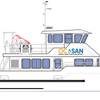Global economic activity proved to be stronger that expected in 1999, according to the monthly report by R.S. Platou Shipbrokers a.s. Most crisis-ridden Asian economies recovered strongly, and the U.S. economy expanded by about four percent for the fourth consecutive year. In Japan the recovery has come earlier and has been stronger than anticipated. In the European Union growth weakened, but is now gathering strength.
World Total output rose from 2.2 percent in 1998 to three percent in 1999. Normally, such a growth should have given much more impetus to seaborne trade than we actually experienced, due to substantial stockdrawing of oil as well as dry bulk commodities.
Shipping markets were generally weak, as a result of the poor tonnage demand trend following the Asian crisis and the lack of significant correction on the supply side.
All Through 1999 the tanker market was on a declining trend that started after the peak of the cycle in the fall of 1997. Freight rates plunged within all market segments. Correspondingly poor market conditions have not existed since the first half of the 1990s. Market conditions last year were strongly dominated by OPEC's campaign to cut oil inventories following the substantial stockbuilding in 1997-98.
The active tanker fleet increased by 2.5 percent from 98 to 99, calculated on an annual average basis. By historical standards this was not an unusually large growth, but in combination with a three to four percent decline in tonnage demand utilization rate fell dramatically.
The secondhand values of tankers dropped moderately over the year, typically by about 10 percent, depressed by the poor freight market.
The reason the fall was not larger is that secondhand prices declined sharply in 1998 in anticipation of a weak 1999 freight market. Activities in the secondhand market were extremely low, reflecting a basically sound financial situation for most tanker owners after a couple of healthy years.
The year 1999 turned out to be much the same as 1998 where average freight rates are concerned. The yearly average tripcharter rates for modern Capesizes fell moderately, while the rates for Panamaxes increased slightly. For Handysized ships, only minor changes in the average freight rates.
The freight rates did, however, start the year at levels substantially lower than they had ended. The main reason for the extremely weak start to the year was a considerable stock depletion in the steel industry during the first half. During the second half, however, increasing activity in the mineral trades and brisk activity in grain trade was noted.
The active dry bulk fleet increased by .5 percent from 1998 to 1999, calculated on a yearly average basis. During the same period, an estimated one percent increase occurred in tonnage demand, and as a result, fleet utilization increased only marginally.
Ship values also entered the year at very low levels, but began to appreciate during the first quarter. The firmer trend continued through most of the year. At the end of the year, prices of 10-year-old ships were, in general, 30 percent above the levels at the beginning of the year.
(Source: Platou Economic Research a.s.)
Subscribe for
Maritime Reporter E-News
Maritime Reporter E-News is the maritime industry's largest circulation and most authoritative ENews Service, delivered to your Email five times per week









